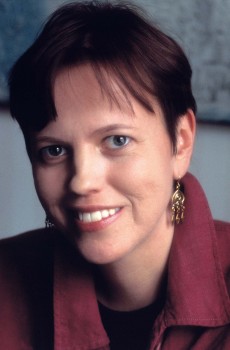Search results for "2010/02/2009/09/2011/04/matti-suurpaa-parnasso-1951–2011-parnasso-1951–2011"
On the waves of our skin
4 December 2009 | Fiction, poetry
The poems in Ilpo Tiihonen’s new collection, Jumalan sumu (‘God’s mist’) – about fakirs, beggars, poets, lovers and life – are tinged with a gentle sense of the ephemerality of human life (see Gatecrashing the universe)
Poems from Jumalan sumu (‘God’s mist’, WSOY, 2009)
SANTO PAN
These mornings when beggars
station themselves at church doors
and a little grace slips through
the fingers of some of us,
it seems for a moment good
That crows are flying about
and princes’ bones are clattering in huge sarcophagi
And now, with a basic shape planned
for the daily bread,
Early morning wakes up in Florence
with black flour in its fingernails More…
Mirkka Lappalainen: Susimessu – 1590-luvun sisällissota Ruotsissa ja Suomessa [Wolf Mass. Civil war in Sweden and Finland in the 1590s]
4 June 2010 | Mini reviews
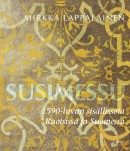 Susimessu – 1590-luvun sisällissota Ruotsissa ja Suomessa
Susimessu – 1590-luvun sisällissota Ruotsissa ja Suomessa
[Wolf Mass. Civil war in Sweden and Finland in the 1590s]
Helsinki: Siltala, 2009. 319 p.
ISBN 978-952-234-016-0
€32, hardback
Sweden at the end of the 16th century was riven by struggles for power: the opponents were the Protestant Duke Charles and Sigismund, King of Poland and Sweden, a strong supporter of the Counter-Reformation in the Nordic lands. A peasant uprising that came to be known as the ‘Cudgel War’ was underway in Finland – then part of the kingdom of Sweden. This book recounts the dramatic history of that civil war and, in line with current interpretive methods of historical research, explodes some popular myths that have been built up around these events. Mirkka Lappalainen has gained recognition as a bold writer who skilfully combines micro- and macro-level history. She characterises Sigismund, whom the Vatican supported to no avail, as a ‘melancholy, absent-minded vacillator, who preferred to play music.’ Lappalainen provides a fascinating alternative historical interpretation of what would have happened if the Vatican’s plans to wrest Finland away from Sweden and unite it with Poland had come to fruition.
New from the archive
30 April 2015 | This 'n' that
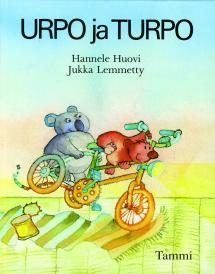 The first of Hannele Huovi’s much loved Urpo ja Turpo (‘Urpo and Turpo’) books – featuring two little bears, the grey, bob-tailed Urpo, who likes flowers, and Turpo, the grey, intrepid adventurer – appeared in 1987.
The first of Hannele Huovi’s much loved Urpo ja Turpo (‘Urpo and Turpo’) books – featuring two little bears, the grey, bob-tailed Urpo, who likes flowers, and Turpo, the grey, intrepid adventurer – appeared in 1987.
With comically characterised illustrations by Jukka Lemmetty, these vignettes cast a philosophical light on life as seen from a small child’s viewpoint, whether the subject is monsters at bedtime, what to play on a rainy day, using the family dog as a sailing ship or learning good manners.
Hannele Huovi (born 1949) won the prestigious Eino Leino Prize in 2009. Her work has been translated into Swedish, Danish, Norwegian, Estonian, German, Japanese, Russian and Arabic.
Fair game
23 October 2009 | This 'n' that
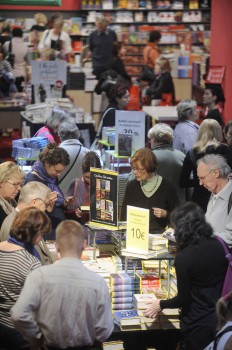
Words for sale: Helsinki Book Fair, 2009. - Photo: Suomen Messut / Kimmo Brandt
The Helsinki Book Fair opened yesterday (22 October), with the theme ‘What’s really happening’, at the Helsinki Exhibition and Convention Centre. Over four days there will be more than a thousand performers (mostly writers and their interviewers) and nearly 300 exhibitors. Last year’s Fair attracted 68,000 visitors.
The words of the theme are borrowed from a 1960s collection of poems (Mitä tapahtuu todella) by Pentti Saarikoski (1937–1983). According to the press release, the theme ‘sums up what literature is about’; moreover, ‘fiction and non-fiction reflect this very day, reinterpreting the past and present glimpses of what is to come’.
What’s really happening, it seems to us, is that inventing catchy titles for commercial purposes is an enterprise that should be undertaken with caution, as it may produce unintentional connotations for the delectation of those in the know… Mitä tapahtuu todella – its title borrowed in turn from none other than the Russian revolutionary Vladimir Ilyich Lenin – was a politically utopian collection in which Saarikoski expressed his belief in dialectical materialism and communism, contrasting American avant-garde art with the Marxist-Leninist utopia in which the writer wished to live.
In recognition of bicentennial 1809, the year in which Finland ceased to be part of the kingdom of Sweden and became an autonomous Grand Duchy of Russia, Sweden is under focus at the Book Fair, and is represented by 27 exhibitors and more than 30 performers. Writers from eight countries in all will visit the Fair, Russia taking part for the first time. Among the visitors are the writers Andrei Astvatsaturov and Herman Sadullajev and the translators Lyudmila Braude ja Anna Sidorova, who were awarded this year’s Finnish Government Prize for Translation.
The Fair is organised by The Finnish Fair Corporation in conjunction with the Finnish Book Publishers Association and the Organisation of the Booksellers Association of Finland.
Sirpa Kivilaakso: Satukuningatar Anni Swan [Anni Swan, the queen of storytelling]
7 May 2010 | Mini reviews, Reviews
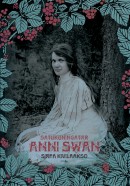 Satukuningatar Anni Swan. Elämä ja teokset
Satukuningatar Anni Swan. Elämä ja teokset
[Anni Swan, the queen of storytelling. Her life and works]
Jyväskylä: Atena, 2009. 275 p., ill.
ISBN 978-951-796-561-3
€ 32, hardback
Anni Swan (1875–1958) was a writer, translator and editor of children’s magazines. Her symbolic tales utilise her highly original language of sensory imagery. Swan’s symbolism is rooted in the golden age of Finnish arts at the end of the 19th century. The pre-eminent setting for Swan’s stories is the Finnish forest. Her ‘eco-criticism’ of practices that exploited the natural environment can be seen as radical for her time. Swan is also considered to be the first true writer of books for young people in Finland. Her stories about upper-class characters who overcome obstacles emphasise the class conflicts and other injustices of their day, yet they have remained popular into the 21st century. This book, based on Sirpa Kivilaakso’s doctoral thesis on Swan’s fairy-tale symbolism, presents a biography of the author, with supporting extracts from her books, diary entries and letters.
What Finland read in April
14 May 2010 | In the news
In April Sofi Oksanen’s best-selling novel Puhdistus, Purge (winner of the Finlandia Prize for Fiction in 2008, WSOY, and now available in English translation) was top of the best-selling Finnish fiction list again. Quite an achievement.
Finns seem to be besotted with Pertti Jarla’s comic books: three of them, set in the weird city of Fingerpori (‘Fingerborg’, Arktinen Banaani), were on the list.
The final volume of artist and writer Hannu Väisänen’s fictionalised autobiography, Kuperat ja koverat (‘Convex and concave’, Otava, 2009), was number five on the list. Number three was a newcomer, Tumman veden päällä (‘On dark water’, Tammi), also an autobiographical novel about childhood, by the the actor Peter Franzén.
Names appearing high on the foreign fiction list in April included Child Lee, Dan Brown, Falcones Ildefonso, Liza Marklund, Pamuk Orhan and W.G. Sebald.
Archives open!
12 December 2014 | This 'n' that
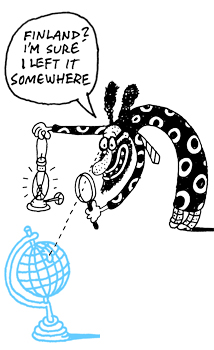
Illustration: Hannu Konttinen
For 41 years, from 1967 to 2008, Books from Finland was a printed journal. In 1976, after a decade of existence as not much more than a pamphlet, it began to expand: with more editorial staff and more pages, hundreds of Finnish books and authors were featured in the following decades.
Those texts remain archive treasures.
In 1998 Books from Finland went online, partially: we set up a website of our own, offering a few samples of text from each printed issue. In January 2009 Books from Finland became an online journal in its entirety, now accessible to everyone.
We then decided that we would digitise material from the printed volumes of 1976 to 2008: samples of fiction and related interviews, reviews, and articles should become part of the new website.
The process took a couple of years – thank you, diligent Finnish Literature Exchange (FILI) interns (and Johanna Sillanpää) : Claire Saint-Germain, Bruna di Pastena, Merethe Kristiansen, Franziska Fiebig, Saara Wille and Claire Dickenson! – and now it’s time to start publishing the results. We’re going to do so volume by volume, going backwards.
The first to go online was the fiction published in 2008: among the authors are the poets Tomi Kontio and Rakel Liehu and prose writers Helvi Hämäläinen (1907–1998), Sirpa Kähkönen, Maritta Lintunen, Arne Nevanlinna, Hagar Olsson (1893–1979), Juhani Peltonen (1941–1998) and Mika Waltari (1908–1979).
To introduce these new texts, we will feature a box on our website, entitled New from the archives, where links will take you to the new material. The digitised texts work in the same way as the rest of the posts, using the website’s search engine (although for technical reasons we have been unable to include all the original pictures).
![]()
By the time we reach the year 1976, there will be texts by more than 400 fiction authors on our website. We are proud and delighted that the printed treasures of past decades – the best of the Finnish literature published over the period – will be available to all readers of Books from Finland.
The small world of Finnish fiction will be even more accessible to the great English-speaking universe. Read on!
Tuomas Kyrö: 700 grammaa [700 grams]
12 November 2009 | Mini reviews, Reviews
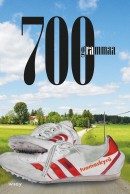 700 grammaa
700 grammaa
[700 grams]
Helsinki: WSOY, 2009. 379 p.
ISBN 978-951-0-35601-2
€ 30, hardback
The genre of the picaresque novel is doing well, and one of its foremost exponents in Finland is Tuomas Kyrö (born 1974). The plot of his ingenious first novel, Nahkatakki (‘Leather jacket’, 2001), revolved around a jacket that moves from one owner to another. His later novels maintain this comical tension, but with a deepening of themes and a more sober outlook. Liitto (‘Union’, 2005) portrayed people scarred by war, while Benjamin Kivi (2007, featured in Books from Finland 4/2007) retold Finland’s history in a light-hearted and anachronistic manner. 700 grammaa is a book about sports fever and family relationships, the exploration of love and the pursuit of dreams. The main character is a boy who at birth weighs only 700 grams, and whose father vows to perform a seven metre long-jump if his son survives. He does, and the father has to devote his life to this almost impossible sporting achievement This novel, with its fast-developing plot and varied narrative techniques, is a paean to the heroism latent in mediocrity.
Memory in my hands
19 August 2010 | Fiction, poetry
A couple of years ago Timo Harju chose the non-military alternative to national service and was detailed to work at an old people’s home. Its director warned him that its inhabitants were ‘no sweet old grannies and grandpas’. Harju thought this might be a joke. In his first collection of poems, entitled Kastelimme heitä runsaasti kahvilla (‘We watered them abundantly with coffee’, Ntamo, 2009), he patiently gathers fragments of dreams and fears, memories and forgotten songs in the house of oblivion, treating them with gentle empathy. Commentary by Pia Ingström
Ward A5, Thursday
The clouds in the nursing home corridors, sky-open springlike after a bathe
and forgotten, in a frayed blue dressing-gown beside an osiery.
The grannies in the nursing home corridors, the last beautiful pride
you keep in a small wooden box behind your forehead:
if the lid opens by accident all the things may drop to the floor
topsy-turvy you won’t be able to find them, your back won’t let you
you won’t recognise them any more even if you do,
the springtime tears your insides to pieces.
Here they come, the grannies.
Better to stay here indoors, the journey to the dining room is a rough one
exposed like this
a long way and all by sleigh.
You stare at the keyhole: the clouds are coming. More…
Funny in favour (again)
8 June 2012 | In the news
The May list of best-selling Finnish fiction titles, compiled by the Finnish Booksellers’ Association, still features two novels about a grumpy old man (see In the news) by Tuomas Kyrö (a grumpy young man): Mielensäpahoittaja ja ruskeakastike (‘Taking offence and the brown sauce’) and Mielensäpahoittaja (‘Taking offence’, both WSOY) were number one and two.
Number three was a work by a classic humorist: Veikko Huovinen (1927–2009) was a highly original and versatile writer whose career lasted almost for 60 years. A selection of his short prose from 1950 to 2001, previously unpublished or published in various magazines, appeared in May: Luonnonkierto (‘Nature’s cycle’, Siltala) immediately shot up to the third place on the month’s list. (You’ll find one of these texts coming up next on this site!)
As summer was approaching at last, the non-fiction list featured several books on birds, grilling and cooking – as well as aphorisms and other food for thought, traditionally bought for young people graduating from school.

